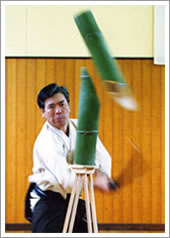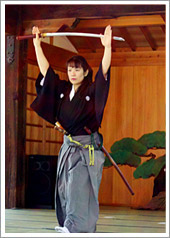- Japanese
- English

Nippon Koden Fushi Muso Kai
Nippon Koden Fushi Muso Kai was established for the purpose of facilitating the activities of Tanaka Fumon, the Soke, in handing down various facets of the time-proven Japanese culture of bushido and tradition and in seeking the origin of wisdom and ideas in applying the knowledge bequeathed by our ancestors to posterity.
The activities of Nippon Koden Fushi Muso Kai in teaching Japanese history, ancient Shinto, Buddhist philosophy, and bushido culture and philosophy entailing practical skills in the martial arts extend globally from Japan to the Middle and Near East as well as Europe and the United States.
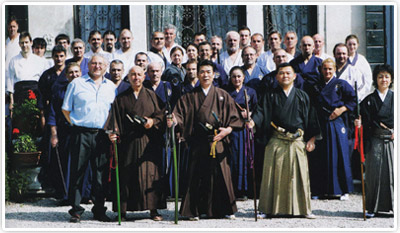
Seminar at the knight’s residence in San Marco near Venice, Italy
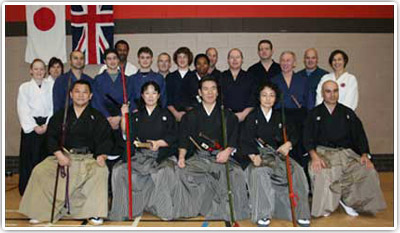
With a main member of the British jujutsu society.
Martial arts taught by Nippon Koden Fushi Muso Kai
- Koden Enshin Ryu Kumiuchi Kenden
- Kukishin Ryu Bojutsu
- Honmon Enshin Ryu Iai Suemonogiri Kenpo
- Tenshin Hyoho Soden Kukamishin Ryu
Koden Enshin Ryu Kumiuchi Kenden
(古傳圓心流組討剱傳)
Koden Enshin Ryu is a school of swordsmanship that originated as Hyoho Kumiuchi Kenden Enshin Ryu, which was a combination of kenjutsu and jujutsu created by Inugami Sakon Shogen Nagakatsu, a Kyoto Imperial Palace guard in the Warring States period from the mid-14th to mid-15th centuries.
In Koden Enshin Ryu, swords with 90 cm blades or longer are used as a traditional rule. At present, large swords with 90 to 130 cm blades are used for exercise.
Kukishin Ryu Bojutsu
(九鬼神流棒術)
In the period of the Northern and Southern Dynasties in the 14th century, Yakushimaru Ryushin fought against the troops of Ashikaga Takauji armed only with the broken shaft of a naginata and defeated his enemies one after another. Emperor Go-Daigo, who was delighted with the service of Yakushimaru, praised him and called his service “a work of the gods.” From that time, Yakushimaru assumed the surname of Kukami (Kuki), meaning “Nine Gods,” and called himself Kukami Takazane. The origin of Kukishin Ryu is Yakushimaru Ryushin’s way of fighting only with the broken shaft of a naginata.
Hanbojutsu is the art of wielding a staff of about 90 cm in length, about half that of a regular staff. Kuriyama Ukon, Oda Nobunaga’s retainer, is said to have defeated an enemy with the cut-off shaft of a spear. This service of Kuriyama’s resulted in the transmission of the art as hanbojutsu.
Honmon Enshin Ryu Iai Suemonogiri Kenp
(本門圓心流居合据物斬剣法)
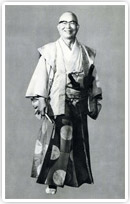
Enshin Ryu Iai Suemonogiri Kenpo is a sword-wielding art based on the vehement swordsmanship founded by Shobe Kobashi, who combined Shinto Munen Ryu with Koden Enshin Ryu in the Edo Bunsei period of early 19th century, and completed by Nikkan Kobashi (photo on the right) in the Taisho period of early 20th century by incorporating the strong points of eight schools.
Suemonogiri Kenpo of the Enshin Ryu consists essentially of swordsmanship for seconding based on bushido and does not involve trial cutting for testing the quality of blades. In Enshin Ryu Iai Suemonogiri Kenpo, the target for cutting is not secured by binding or any other method. Cutting an unsecured, freely-movable stationary target in honor of bushido is the rule of the school’s tradition.
Tenshin Hyoho Soden Kukamishin Ryu
(天眞兵法宗傳九鬼神流)
Tenshin Hyoho traces its origins back to the period of the Northern and Southern Dynasties in the 14th century and developed as a martial art of the Southern Dynasty. The Kuki Navies of Kumano and Toba are said to have refined the art during the Warring States Period and the rule of Toyotomi Hideyoshi between mid-14th and late 15th centuries, and it was subsequently handed down into modern times as a secret bujutsu unique to the Kuki Family.
Tenshin Hyoho is rooted in various studies and arts including ancient astrology, tactical battle formation, castle construction, herbalism, ancient Shinto, sorcery, and the Way of Yin and Yan, and a vast range of training systems have been handed down through this tradition including kenjutsu, sojutsu (spearsmanship), naginata, bojutsu, hanbojutsu, token (throwing of hand-held weapons), and ninpo (the art of the ninja).
Fumon TanakaPersonal History
Acting soke Ukyo Tanaka
|

